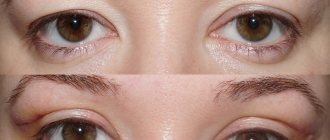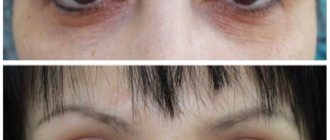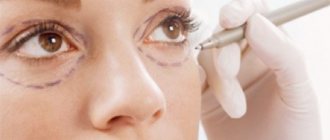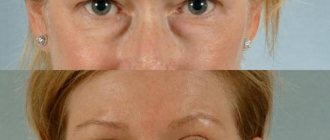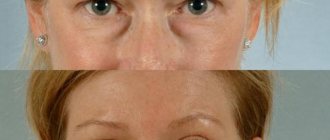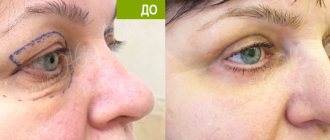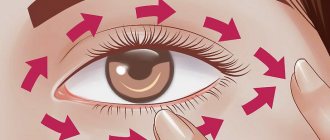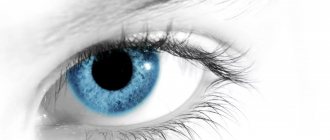No woman wants to put up with age-related changes. And modern plastic surgery helps them stay young, beautiful and inspiring for as long as possible. For example, blepharoplasty - eyelid correction surgery - is designed to remove defects that appear due to age. It improves the shape of the eyelids, gives expressiveness to the eyes, making the face look younger.
Blepharoplasty at the Vita+ clinic (Abakan) will help all patients make their eyes more open and expressive. The procedure is aimed against lower eyelid hernias, it tightens the skin around the eyes and eliminates deep wrinkles.
Indications and contraindications for eyelid correction
The main goal of blepharoplasty is aesthetic; the look after plastic surgery will become more expressive. The second aspect, which is also an indication for eyelid correction, is the presence of excess skin and fat deposits in the area around the eyes. These defects are not only unaesthetic, but lead to a decrease in eye health, as they lead to weakening of the orbicularis oculi muscles.
Indications for blepharoplasty are the following conditions:
- Overhang of the eyelid over the eye;
- The presence of deep wrinkles in the area around the eyes;
- The appearance of multiple facial wrinkles;
- Pathologies of the formation of the upper eyelid with a risk of visual impairment;
- Flabbiness of the skin and the appearance of “bags” under the eyes.
Eyelid surgery also has contraindications:
- Bleeding disorders;
- History of cancer;
- Endocrine system disorders;
- Skin diseases;
- Eye diseases.
When is it not necessary to have blepharoplasty?
In fact, in addition to contraindications, there is another important factor. Blepharoplasty does not need to be done when it is not needed!
Don't try to look for imperfections in yourself. Don’t go after a fly with a gun (I’m talking about barely noticeable facial wrinkles on thirty-year-old girls). Always think twice and talk to your doctor. You may not need surgery.
Follow the link and book a consultation with me. I will be happy to answer your questions and dispel your fears before surgery!
Main types of blepharoplasty and their features
Upper eyelid surgery
The procedure is aimed at eliminating the overhanging eyelid, and also allows you to change the shape and shape of the eyes if desired. Designed to get rid of sagging skin in the area around the eyes. After the correction, the seams are almost invisible. It is performed under local anesthesia. After the operation, the patient can be immediately discharged home.
Lower eyelid surgery
It is carried out in 2 ways: using an incision along the eyelid line and using a puncture to remove the fat layer. The first method is aimed at removing excess skin and is used more often. It is performed under local anesthesia. After the operation, the patient can be immediately discharged home.
Circular blepharoplasty
Plastic surgery that helps get rid of several defects at once:
- Wrinkles;
- Asymmetrical;
- Bags under the eyes;
- Excess fat.
Can be performed under general anesthesia.
Correction of failed blepharoplasty
Have you already undergone a similar operation, but did not see the effect? Blepharoplasty can be repeated to improve the results of the previous operation. Interval between operations: 2-3 months. Preparation must also be completed for a repeat operation.
Risks of anesthesia
Anesthesia is necessary for complete loss of tactile sensitivity of nerve endings. During the procedure, the patient does not feel pain and is fully conscious if anesthetic drops were used.
The patient's health may suffer from anesthesia. This is stress for the body, so sometimes problems with the heart and blood vessels, nervous system and breathing begin if general anesthesia was given.
Risks:
- severe swelling;
- hematomas;
- injury to the delicate skin around the eyes;
- infection due to violation of rules;
- retinal detachment;
- drooping upper eyelid;
- hypertension;
- perforation of the eyeball.
Preparing for blepharoplasty
The duration of the operation depends on the type of blepharoplasty performed and the number of defects being corrected. Before the procedure, the doctor determines the type of skin, its condition, as well as the condition of the muscles and structural features of the skull.
When talking to your doctor, be sure to tell them about any allergies you have or possible adverse reactions to medications. This will help the doctor choose the right type of anesthesia. Before blepharoplasty, it is not recommended to visit beauty salons and carry out a certain number of cosmetic procedures at home.
Before blepharoplasty, we recommend visiting an ophthalmologist and obtaining permission to perform this operation. Pay special attention to the presence of dry eye syndrome and glaucoma. These diseases should also be reported to the surgeon.
If you have a history of diseases such as diabetes, cardiovascular diseases, or endocrine system disorders, then, unfortunately, blepharoplasty is contraindicated for you.
After collecting information about your health, the doctor will talk about the operation, possible consequences and the recovery process. To clarify some conditions, he may prescribe tests, including checking the blood for clotting and the absence of various infections.
Preparation for blepharoplasty includes:
1. Increased water consumption (this recommendation continues after surgery);
2. Stop smoking. Nicotine use slows down the recovery process;
3. You cannot take aspirin, dietary supplements and homeopathic remedies.
If the operation is to be performed under local anesthesia, you will only be required to undergo a series of tests. If general anesthesia is used (for example, in the case of circular blepharoplasty), then in addition to the tests, an ECG and fluorography will be required. Whichever method of anesthesia is chosen, you will receive a preliminary consultation with an anesthesiologist.
Cons of rehabilitation
The recovery period is long and accompanied by discomfort. The rehabilitation period is accompanied by the formation of hematomas, bruises and swelling under the eyes.
Vision remains blurry for several days after surgery. Improves gradually.
The treated areas are slightly sore. The person undergoing surgery has to take painkillers.
Some areas remain numb. Over time, this feeling passes. Dry eyes are possible; moisturizing drops are prescribed.
Rehabilitation after blepharoplasty
We recommend that you first ask your doctor what you will need during the recovery period.
In the first days after blepharoplasty, stitches can cause trouble. Patients also complain of excessive sensitivity of the eyes to light, the appearance of swelling and bruises. Don't be alarmed, this is a normal reaction of the body to surgery. These sensations will last the first two days, and then will gradually pass.
You can reduce swelling with cold compresses. Hematomas disappear within 2 weeks.
Full recovery occurs after 7-10 days. Medicines and procedures prescribed by your doctor will speed up this period. However, remember that after plastic eyelid correction, many common medications that we often take for pain are prohibited: ibuprofen, aspirin and the like. Follow your doctor's recommendations!
Sutures are removed 7-9 days after blepharoplasty. If you experience any complications or negative symptoms during the postoperative period, notify your surgeon immediately!
Late complications after eyelid surgery
Some problems after surgery may appear after the rehabilitation period is over:
These include:
- Visible asymmetry of the eyes (appears due to uneven stitches or improper scarring)
- Dehiscence of seams (if not corrected, a rough scar will form)
- Dry keraconjunctivitis (eliminates with special drug treatment)
- The effect of “weathering of the eyes” (this is when the eyelids do not close completely)
- Tearing (caused by improper scarring or edema)
- Blepharoptosis
Most of the undesirable consequences listed above are extremely rare . And can be eliminated by repeated surgery. To minimize the risk, it is important to find a plastic surgeon with extensive experience, carefully consider the process of preparing for surgery and follow the doctor’s recommendations during rehabilitation .
Is blepharoplasty dangerous?
Blepharoplasty is a plastic surgery, so it must be performed by a highly qualified surgeon. The eyelid area and area around the eyes is a sensitive area with thin skin.
Many people who have indications for eyelid correction are afraid to have surgery because they believe in myths. For example, there is a fear that blepharoplasty will lead to worsening vision. However, doctors say the opposite. Temporary deterioration is possible due to swelling of the eyelids, but as the swelling goes away (2-3 days), vision will improve.
Sutures and marks from them also frighten patients. There is nothing to be afraid of here either, since the seam is made in the crease of the eyelid, which makes it as invisible as possible. Thin incisions also minimize surgical scars.
The patient can return to his normal lifestyle within 2 weeks after the correction.
Is it true that blepharoplasty is very painful?
Any operation is an intervention in the body, and of course, one cannot expect pleasant sensations from it. It will be somewhat unpleasant for you during blepharoplasty. But we use exclusively high-quality painkillers that will reduce discomfort to a minimum.
The skin of the eyelids is indeed a very sensitive area. After the operation, there will definitely be pain in the places where the stitches are placed. But this, firstly, indicates that everything went correctly, and secondly, it can be relieved with painkillers. Discuss the choice of drug with our specialist - he will help you choose the most suitable remedy.
Some of our patients note that the healing sutures itch quite a lot. This can also cause some discomfort, but like the previous described effects, it passes relatively quickly.
Feelings after surgery
After blepharoplasty, the patient may experience the following symptoms:
- swelling, feeling of heaviness of the eyelids;
- pain in the intervention area;
- hematomas (usually under the lower eyelids);
- dry eyes or, on the contrary, lacrimation;
- diplopia (double vision), blurred vision.
Not all the symptoms from the list will necessarily be present; the appearance of some of them depends on the type of blepharoplasty, the patient’s skin type (swelling is more pronounced on oily skin than on dry skin), lifestyle, diet, compliance with all preoperative doctor’s recommendations and other factors. All these phenomena are reversible and disappear without a trace within a few days or by the end of the recovery period.
Advantages of the EMC Clinic
Plastic surgery on the eyelids includes a number of different correction options and requires the highest qualifications and precision from the specialist. Blepharoplasty at the EMC clinic is the best plastic surgery specialists with international practice and extensive practice, mastering the most complex methods of eyelid correction.
Innovative technical equipment, a modern fully equipped operating unit, the possibility of a comprehensive examination before surgery, and a postoperative hospital allow the EMC Aesthetic Clinic to maintain the highest level of medicine in Moscow.
Contraindications to transconjunctival plastic surgery
This technique has appeared relatively recently in plastic surgery. The correction is carried out using an incision in the conjunctiva of the eye. During such an operation, the organ of vision is not damaged, soft and mucous tissues are not seriously damaged. The rehabilitation period after such surgery is easy, with no complications. The operation is not performed on patients with the following indications:
- intraocular pressure;
- dryness of the sclera of the eye;
- HIV, other immunodeficiency conditions;
- menstrual bleeding;
- hypertension;
- failure of the endocrine system;
- oncology.
No plastic surgeon can give a 100% guarantee of a successful outcome of the operation. During anesthesia and in the postoperative period, the body may behave differently, it depends on the individual characteristics of the patient. To minimize negative consequences, the most complete examination of the body is necessary before surgery. Most complications after unsuccessful blepharoplasty lead to reoperation.
Choosing a qualified plastic surgeon and a reputable clinic will reduce the risk of unpleasant complications to zero. Correct behavior of the patient during the rehabilitation period and compliance with all recommendations of the attending physician will help to avoid troubles.
If you are not sure that you meet all the safety requirements, it is worth considering non-surgical eyelid blepharoplasty methods.
Rehabilitation period by day
1 day. The patient is discharged from the clinic after the operation. On this day, the eyes are most sensitive to light, so it is recommended to have dark glasses with you to put on before going outside. By evening, swelling increases. Possible lacrimation, dry eyes, blurred vision.
To reduce pain, your doctor may prescribe analgesics. Any medications (drops, ointments) should be used only as prescribed by a doctor. It is necessary to remain calm and avoid any strain on the eyes. You need to sleep on your back, with your head elevated, to improve the flow of fluid from the upper body and reduce swelling.
2-3 days. Painful sensations decrease, swelling, on the contrary, increases, reaching a maximum on the 3rd day. It is acceptable to use a cold compress on the eyes - apply an ice pack wrapped in several layers of clean, dry cloth to the operated area. There may be numbness and impaired sensitivity of the skin in the surgical area.
These days you can already wash your face and hair, trying not to wet the skin of your eyelids. As before, you should try not to strain your eyesight, devote a minimum of time to reading, watching TV, and working at the computer. The patient must continue to follow all the doctor’s prescriptions - drops, treatment of sutures if necessary.
3-5 days. Symptoms persist or improve slightly.
5-7 day . Usually on the 5th day a follow-up examination is scheduled in the clinic, the surgeon removes the sutures (if self-absorbable threads were not used). There may be redness and slight swelling in the area of the sutures.
7-10 days. Symptoms gradually decrease, and by day 10 the patient can return to normal life with some restrictions on eye strain. After 10-14 days you can wear contact lenses.
The final result of the operation can be assessed after 1-2 months. By this time, the epidermis of the skin of the eyelids is renewed, the seams become unnoticeable. After six months, postoperative scars are almost impossible to detect; they look like a thin strip in the crease of the upper eyelid or along the lower edge of the eyelashes.
